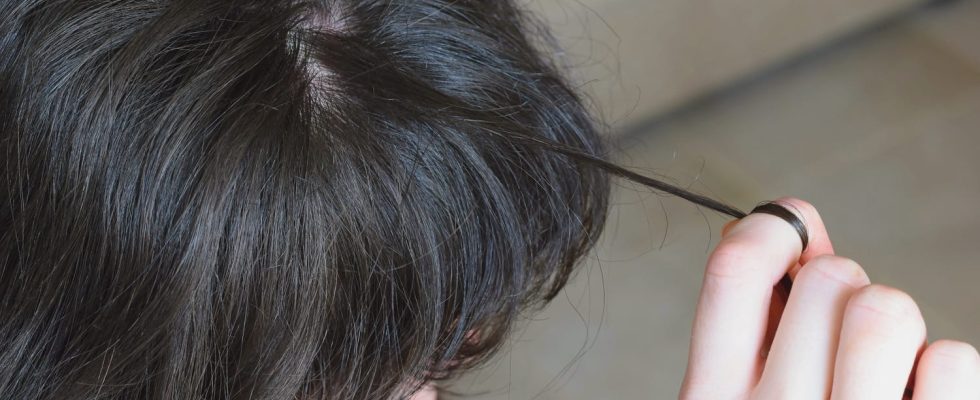Trichotillomania (or trichomania) is a mental disorder characterized by compulsive pulling out of hair, beard hair, eyelashes, eyebrows… What are the causes? Is it OCD? What treatment to stop? Minoxidil?
Trichotillomania is mental and compulsive disorder which is manifested by the pulling out of hair or body hair (eyelashes, eyebrows, beard hair, etc.). Where is that from ? What are the causes ? Is it a disease? A TOC? Does body hair and hair grow back after trichotillomania? Discovery of this problem and its solutions.
What is the definition of trichotillomania?
There trichotillomania East compulsive behaviorand organized, hair pulling which leads to the disappearance of hair (alopecia) on a delimited area of the scalp, as well as on other hairy areas, such as eyelashes and eyebrows. If the disorder is referred to by the same name for the child and the adult, its forms differ.
- Trichotillomania in children is a repetitive compulsion most often linked to a temporary episode of stress and is more common in boys.
- Adult trichotillomania is more complex and comes in two clinical forms: a form called “concentrated on the gesture” in which the compulsive urge to pull one’s hair out is consciously experienced and followed by a sense of relief or guilt, and a so-called “automatic” form in which the hair pulling is performed unconsciously and does not provide subsequent relief.
What are plucked hairs? Eyelashes, eyebrows, beard?
“There trichotillomania can affect all skin appendages, i.e. hair, beard hair, eyelashes or eyebrows. In the specific case of nails, we then speak ofonychophagia”, says Dr Malekpour, psychiatrist at the Clinique des Boucles de la Seine.
What are the causes of trichotillomania?
In the child, trichotillomania is often related to stress and is therefore one of the symptoms of anxiety. Other factors are involved in the onset of the disorder such as heredity, or in women, the menstrual cycle. Indeed, an upsurge in the symptoms of trichotillomania is observed during the menstrual period.
Is trichotillomania an OCD?
Yes, but “we must distinguish trichotillomania which is a subtype of OCD (Obsessive Compulsive Disorders), of purely anxious origin, Tics, disorders of neurological origin, with jerky and disorganized but conscious muscular movements, and aggravated by anxiety. Their respective treatments are not the same“, explains Dr. Malekpour.
What are the symptoms of someone with trichotillomania?
In addition to the compulsion to pull, trichotillomania is defined by the following criteria:
- an obsessive character, i.e. a perception of increasing tension before pulling and in the event of resistance to the pulling behavior,
- A feeling of relief after the tearing and an extinction of the tension
- The absence of other mental disorders or skin conditions (such as alopecia areata) that may cause this behavior,
- Difficulties or social or professional repercussions expressed by the patient.
- Trichotillomania known as “concentrated on the gesture”: the desire to pull hair out is fully conscious, the urge is irresistible. The gesture is followed either by a feeling of appeasement, or by a feeling of guilt. This corresponds to a symptomatology of anxiety origin.
- The so-called “automatic” trichotillomania: hair pulling is carried out without being fully aware of it in various common situations (work, leisure). It is not preceded by a phase of tension (irrepressible urge) and does not provide subsequent relief.
In children, trichotillomania particularly affects boys and most often manifests itself in times of stress. The disorder is usually transient and resolves spontaneously. “It is often associated with onychophagia, a very common symptom of stress, including in adults, which consists of compulsive nail biting. The risk in children, apart from an aesthetic stigma, is the ingestion of their hair and/or nails over time, which can lead in extreme cases to intestinal obstructions on piles of these materials. trichobezoar”underlines the specialist.
The diagnosis of trichotillomania is based on the interrogation and the clinical signs on the one hand, and on the observations of the patient’s entourage on the other hand.
What is the treatment for trichotillomania?
Severe forms of trichotillomania require appropriate care: it is mainly based on:
→ A behavioral psychotherapy called CBT (Cognitive-Behavioral Therapy) intended to re-educate the patient in the face of his anxiety.
→ “The prescription of psychotropic antidepressants may be associated in severe cases but their efficacy is poorly demonstrated in trichotillomania“, comments Dr. Malekpour.
→ Minoxidil is the most effective treatment for hair loss. This lotion, recommended at 2% for women and 5% for men, is available without a prescription. If this drug can indeed promote regrowth, it will not work miracles until the patient is psychologically treated because this is the real source of the problem.
→ hypnosis can also be useful in this type of disorder because it will help to understand the origin.
Thanks to Dr. Paul Malekpour, psychiatrist at the Clinique des Boucles de la Seine.
